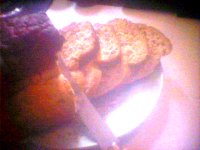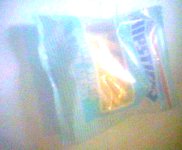Apologies for the poor quality of the pictures on this page - they were all taken with a Logitech Quickcam.
 The important factors to remember when making the ideal sandwich are the ratios between the various ingredients and their strengths, and the aim is to make both the flavour and texture exactly right. So, if you use stronger cheese, you have to use less of it to create the right effect. If you use cheese which is too strong, there will be so little cheese that the texture will just be that of bread. Besides which, strong cheese tends to crumble and/or leave a slimy residue on your fingers. I usually use strength 3 Irish Wexford medium cheddar.
The important factors to remember when making the ideal sandwich are the ratios between the various ingredients and their strengths, and the aim is to make both the flavour and texture exactly right. So, if you use stronger cheese, you have to use less of it to create the right effect. If you use cheese which is too strong, there will be so little cheese that the texture will just be that of bread. Besides which, strong cheese tends to crumble and/or leave a slimy residue on your fingers. I usually use strength 3 Irish Wexford medium cheddar.

 I find white or brown bread rather flavourless, and prefer wholemeal bread (which is also the most full of fibre, and therefore the best for you). You'll need some sort of spread to stick the cheese to the bread and prevent the sandwich from tasting too dry. I tend to use olive spread but sunflower spread (margarine) is fine, too. Butter is too difficult to spread and will make the bread curl up, but if you have no alternative, scrape off very thin slices of butter and just place them on the bread, don't attempt to spread them other than to just stick them to the bread.
I find white or brown bread rather flavourless, and prefer wholemeal bread (which is also the most full of fibre, and therefore the best for you). You'll need some sort of spread to stick the cheese to the bread and prevent the sandwich from tasting too dry. I tend to use olive spread but sunflower spread (margarine) is fine, too. Butter is too difficult to spread and will make the bread curl up, but if you have no alternative, scrape off very thin slices of butter and just place them on the bread, don't attempt to spread them other than to just stick them to the bread.
 One serving of sandwiches consists of three slices of bread. If you're not very hungry and your loaf is very large, you can use use two, and if you're very hungry and your bread is very small, you can use four, but three is the optimal number nearly all the time, and the rest of this document assumes three slices (you'll have to figure out how to adjust the method for an even number of slices youself). You can adjust for how hungry you are by modifying the thickness of the slices (ensuring that your cheese thickness is adjusted in proportion).
One serving of sandwiches consists of three slices of bread. If you're not very hungry and your loaf is very large, you can use use two, and if you're very hungry and your bread is very small, you can use four, but three is the optimal number nearly all the time, and the rest of this document assumes three slices (you'll have to figure out how to adjust the method for an even number of slices youself). You can adjust for how hungry you are by modifying the thickness of the slices (ensuring that your cheese thickness is adjusted in proportion).
To a certain extent, you can adjust the cheese to bread ratio to suit how rich you would like your sandwich. For example, if I'm going to be eating the sandwiches on a long journey, I tend to use less cheese. Beware of increasing the amount of cheese too much, because there are few things worse than excess cheese.
 Of the three slices, butter one side of one of them entirely and butter half (the squarer half) of one side of another. Next, cut the cheese into slices (a danish-style cheese slicer is almost essential here) and spread the slices out on the surfaces of bread which are covered with spread so that none of the spread-covered bread is visible (each point on the surface should be covered by either 1 or 2 layes of cheese, unless you are using very strong cheese).
Of the three slices, butter one side of one of them entirely and butter half (the squarer half) of one side of another. Next, cut the cheese into slices (a danish-style cheese slicer is almost essential here) and spread the slices out on the surfaces of bread which are covered with spread so that none of the spread-covered bread is visible (each point on the surface should be covered by either 1 or 2 layes of cheese, unless you are using very strong cheese).

Next, place the unbuttered layer of bread over the one which has been covered entirely with cheese and place the half-covered layer of bread on top of this. Now with a single cut of your breadknife you can cut all three slices in half. Finally, place the unbuttered half-slice of bread onto the half cheese covered slice, thus creating three sandwiches each consisting of two half slices with cheese in between.

Now, unless you've used crunchy French bread (which is another sandwich entirely) your sandwiches won't be crunchy at all, so in order to introduce some "crunch factor" you'll need a packet of crisps. I prefer salt and vinegar flavour (although I'll occasionally settle for prawn cocktail flavour just to be exotic). Salt is in the bread anyway, and potato and cheese obviously go together (just consider baked potato) so this isn't strange at all. The salt and vinegar act as flavour enhancement and give the sandwich a bit of tang. Again, when laying out the crisps (between the layer of cheese and the unbuttered layer of bread). Again be sure to cover all the cheese completely lest you get a bite with no crisp or not enough crisp. You'll probably want to make the crisps two or even three layers deep.
 Lately, I've switched to using salt and vinegar flavoured chipsticks instead of crisps, as these give much more of a satisfying and consistant crunch. These will only need a single thickness, but this is not a problem since they tesselate very well (particularly when their length corresponds to the width of your semi-slice).
Lately, I've switched to using salt and vinegar flavoured chipsticks instead of crisps, as these give much more of a satisfying and consistant crunch. These will only need a single thickness, but this is not a problem since they tesselate very well (particularly when their length corresponds to the width of your semi-slice).


 To follow I like a nice juicy, crunchy apple such as a granny smith (although some find these too sharp and prefer to go for something sweeter - however apples which have a "grainy" texture should be avoided at all costs). These do a great job of cleaning out the mouth of any spare sandwich crumbs. Apples are best eaten by cutting into quarters through the central axis (so that you get four idential pieces, assuming your apple has perfect rotational symmetry) and then slicing out the central piece (including pips) with a small sharp knife (taking care to cut away from your fingers). If you have no knife handy, you'll just have to eat it the old fashioned way (from the outside in) but you'll probably end up with apple juice all over your fingers.
To follow I like a nice juicy, crunchy apple such as a granny smith (although some find these too sharp and prefer to go for something sweeter - however apples which have a "grainy" texture should be avoided at all costs). These do a great job of cleaning out the mouth of any spare sandwich crumbs. Apples are best eaten by cutting into quarters through the central axis (so that you get four idential pieces, assuming your apple has perfect rotational symmetry) and then slicing out the central piece (including pips) with a small sharp knife (taking care to cut away from your fingers). If you have no knife handy, you'll just have to eat it the old fashioned way (from the outside in) but you'll probably end up with apple juice all over your fingers.

Finally, if you're still hungry (and I usually still am) eat some cake. My favorite is an American style double chocolate chip muffin (what American's would call a British style double chocolate chip muffin, confusingly). These go down really well after an apple.

 It's nice to have something to drink with the sandwiches and cake. I prefer to drink orange juice with my sandwiches (the cheap sort, not the expensive freshly squeezed sort with bits in).
It's nice to have something to drink with the sandwiches and cake. I prefer to drink orange juice with my sandwiches (the cheap sort, not the expensive freshly squeezed sort with bits in).
Once you've discovered the recipe for your perfect lunch, you might want to eat it every day (after all, why have something which isn't your favorite when you can have your favorite?) You'll then want to work things out so that you have to go shopping as infrequently as possible.
A loaf of bread lasts 4 days at 3 slices per day if you don't eat the end pieces (and who does?) The best before date usually corresponds to the 3rd day but it's still edible on the 4th. Any later than that, however, it's really only suitable for the ducks. Coincidentally, the other items which don't last very long, the double chocolate chip muffins, also come in packs of 4 so with a bit of careful planning you can get away with going shopping no more often than every 4 days. All the other things can just be bought whenever you think you're going to run out in the next 4 days.
But this all seems rather inflexible. What if you're invited to go out to lunch one day? Well, if you know far enough in advance you can work it out so that that would happen on a "day 1" (which can be postponed a day). For example, if your occasion would fall on a "day 2", you could have lunch elsewhere the day before. And if you really want to do something last minute, you can always make some toast for a tasty evening snack and double chocolate muffins are too nice to ever be redundant.
Finally, a short word on packed lunches, for which these sandwiches are ideal. Wrap them in clingfilm or put them in a sealable freezer bag, and do the same with the cake (the apple is okay on it's own). Note, don't put the crisps in the sandwiches before you're ready to eat them or they'll go soggy and horrible. Also ensure that your drink is sealed tightly in a leak-proof container. There is absolutely nothing worse than sandwiches which have been sitting in a puddle of liquid. Put everything in a plastic box such as an 2-litre ice-cream carton (everything should fit if you're good at jigsaw puzzles and not too greedy - you might have to squash the lid down a bit to get it to seal but this won't matter). If making the sandwiches the night before your outing, leave them in the fridge overnight to keep them fresh.
Contrary to popular belief, it is actually possible to have substances other than cheese in a sandwich if you're not a vegetarian (and if you are, I have absolutely no sympathy.) Sandwich ham or other cold meat works well and can also be used with crisps. My father likes cold, congealed gravy in sandwiches. Paté can be quite nice, too.























































